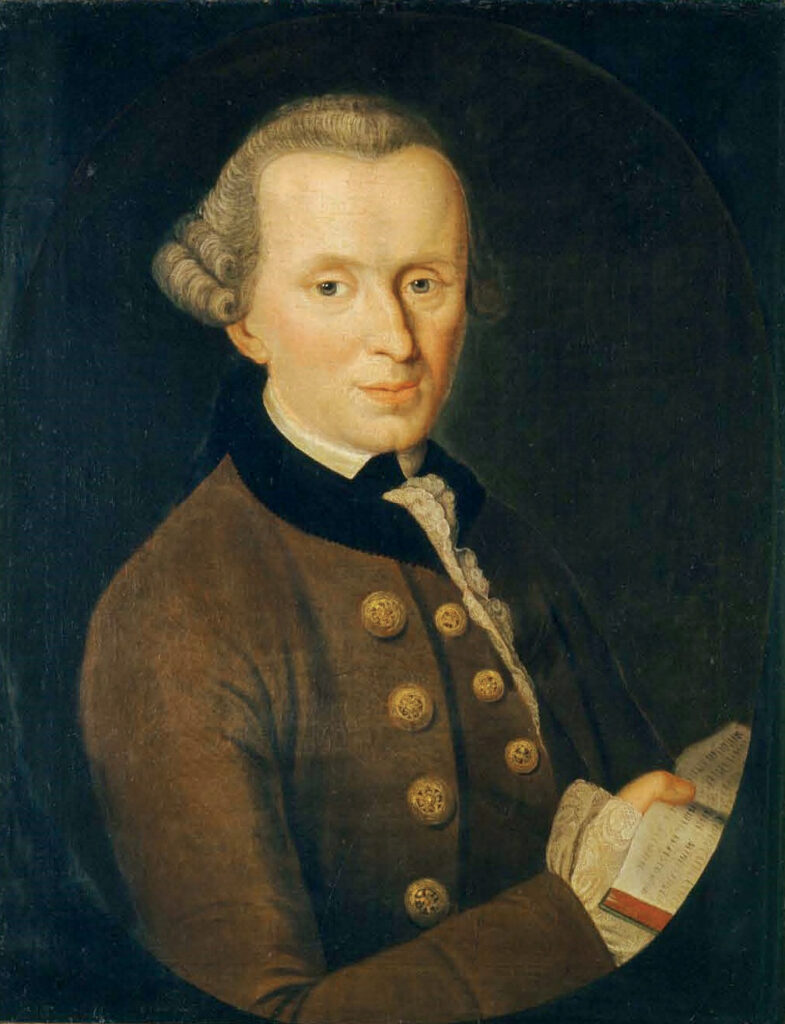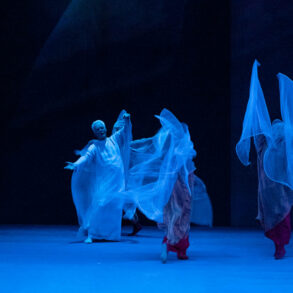Immanuel Kant is celebrating his 300th birthday! What better reason to follow the thoughts and insights of the founding father of modern philosophy with professor Eckart Förster? It’s an arduous journey that provides a wonderful vantage point at the end: an realization of how opinion can become understanding [of facts, wissen] and understanding [of objects, kennen] can become cognition.
Discussions of Kant’s epistemology usually proceed from his Critique of Pure Reason (1781), and for good reason. But, in the years before its publication, the so-called pre-critical period, Kant made a number of discoveries that form the basis of his mature philosophy. There are three insights in particular without which the Critique itself would not have been possible. The first concerns the difference between logical and real possibilities; the second, the differences between the two stems of our cognition; the third, reason as the source of illusions. I will begin with the first two and discuss the third insight at the end of this essay.
Formal and Real Possibility
Kant recognized early on that a proof for the existence of God à la Descartes was not possible. Descartes had argued that the concept of God as the most perfect being must include existence, for otherwise, a more perfect being would still be possible, i.e., a God who actually exists. Kant objected: even when the concept of God is the concept of a being that contains all realities and is thus perfect, existence is not a reality (not a predicate or a determination of an object). When we compare the thought of an actual object with the thought of the same object as a possible but not yet actualized object, we find that both thoughts use the same set of predicates. “Existence cannot, therefore, itself be a predicate.”1 Thus, existence cannot be contained in the mere concept of something, not even in the concept of God.
Nevertheless, at this time, Kant held that a proof for the existence of God was possible, but only indirectly and in relation to a different concept, namely, the concept of possibility. To judge that something is possible means to say that the representations [Vorstellungen] that make up the judgment do not contradict each other. This is the formal condition of possibility. But, there is also a material condition: in every comparison, what is to be compared must be given. If there is nothing to compare, there can be no comparison and therefore no possibility. This means, explains Kant, that nothing can be thought as possible, unless that which is real, in every possible representation, exists. And, to be sure, it must exist by necessity, for without this, there would be no possibility, i.e., possibility, itself, would be impossible, which cannot be thought without self-contradiction. Consequently, the possibility of all things presupposes a necessary existence.
However, Kant soon realized that hidden within his argument was the presupposition that there is thinking. The alleged necessity of all possible realities is solely a hypothetical necessity and presupposes that possibilities are brought into consideration. But, this, itself, is not necessary. As Kant later wrote in the Critique of Pure Reason, “For I cannot form the least concept of a thing that, if all its predicates were cancelled, would leave behind a contradiction . . . .”2

Thus, Kant came to the conclusion that all theoretical proofs for the existence of God are based on a confusion of the necessity of thought with the necessity of things. But, when this is so, one must distinguish not only a formal and a material condition of conceptual possibility, but rather also a formal and a material component in relation to the possibility of things. In other words, there is a fundamental difference between thinking [Denken] an object and cognizing [Erkennen] the same. In order to think an object, its concept must be free of contradictions. But, in order to cognize it, one must know that the object of which one thinks also has objective reality or is “really possible.” Otherwise, “through [the concepts] one has, to be sure, thought but not in fact cognized anything through this thinking, but rather merely played with representations.”3 When the concept is an empirical concept, experience shows that its object is “really possible,” since it is given in perception. When, however, it is a matter of an a priori concept, as is the case in philosophy, one must be able to show how its object is possible, in order to cognize the objective reality of its concept. Is such a priori cognition possible? Can philosophy prove the objective reality of its a priori concepts? To answer this question in general is one of the main tasks of Kant’s Critique of Pure Reason.
Two Stems of Human Cognition
The second result of Kant’s pre-critical writings, which is essential for understanding the epistemology of the Critique, concerns the fundamental difference between thinking and perceiving. Both the rationalists and the empiricists among his predecessors assumed a merely quantitative or gradual difference between the two. Initially, Kant shared this approach, but from 1768 onwards, he believed he could show its falsity. This conviction was triggered by his exposition of “incongruent counterparts,” i.e., such objects that, in terms of the size, proportion, and position of their parts, are completely identical, but which nevertheless cannot have common boundaries and, thereby, are not identical—for example, the two human hands: “The right hand is similar and equal to the left hand. And if one looks at one of them on its own, examining the proportion and the position of its parts to each other, and scrutinizing the magnitude of the whole, then a complete description of the one must apply in all respects to the other, as well.”4 Although conceptually indistinguishable, the left and right hand (like all incongruent counterparts) are nevertheless distinct and as such real and able to be sensed.
From this, it seems to follow that thinking and perception cannot differ from one another solely by degrees, but rather that, on the contrary, they must be observed as two fundamentally different sources of cognition, each with their own conditions and limits. Sensory objects are, consequently, not “objects of reason” (things in themselves), but rather their “appearances.” Both “stems” of cognition are equally necessary for human cognition, for, via thinking, no objects are given, and, via perception, no things in themselves are cognized.
The Critique of Pure Reason
In the Critique of Pure Reason, Kant first brings sensibility and understanding into consideration separately, in order to then investigate their working together in cognition. “The capacity (receptivity) to acquire representations through the way in which we are affected by objects is called sensibility.”5 The effects of this process are therefore “modifications of our state,” i.e., representations “in us.” What is given are not objects but rather subjective inner sensations [Empfindungen]. But how, then, is it possible to ever have cognition of objects outside of us?
Kant’s first step towards solving this problem is the recognition that the concept of space cannot be abstracted from external experience. For how could this happen? First, I would have a sequence of sensations in the inner sense, one after the other. In order to gain the representation of space from this, I would have to have the ability to abstract from them the representations of the coexistence of different places and their simultaneity. Now, two things, A and B, are simultaneous when the perceptions of A and B proceed mutually and can follow one another. But, in the inner sense, everything is successive, and each new representation is later than the previous one. In the inner sense alone, it is impossible to present a manifoldness as simultaneous and thereby as distinct from myself. A distinction between a sequence of representations in me and something permanent outside me, between a subjective sequence of perceptions and an objective order of coexisting elements, cannot, thus, be made on the basis of the inner sense alone: the a priori representation of space makes the experience of simultaneity possible in the first place and, therefore, cannot be abstracted from it.
According to Kant, this means that space is a form of intuition that enables me to represent sensations as alongside one another and distinct from myself. At the same time, it restricts me: I can only represent something as distinct from myself, in that I think of it as being situated in some other place. Notwithstanding, space, itself, as a form of external intuition, does not yet refer to something distinct from myself. For this, concepts and judgments are required, which only reason can provide. “We can, however, trace all actions of the understanding back to judgments, so that the understanding in general can be represented as a faculty for judging.”6 Since reason does not generate its own intuitions, but rather, for its activity, is dependent upon a manifoldness given to it in the senses, reason must be able to amalgamate this manifoldness in such a way that the manifoldness can be comprehended as something about which judgments may be formed.

We can now sketch Kant’s argument more precisely. Sensibility as the “capacity (receptivity) to acquire representations” is a passive capacity. The manifoldness that it contains is, due to this passivity, unconnected. What we can distinguish in sensibility is distinct and unconnected in it; each impression is nothing but “absolute unity.”7 Thereby, in order for this material to become cognition, it must first be traversed and amalgamated and then comprehended.
Were we to lose sight of the first impression while perceiving the second, the second would be the first and only impression, and no unity could arise. So, when we perceive the second impression, the first must be reproduced as an impression, which was perceived, but is no longer being perceived. This second act is likewise required for each representation of spatial extension and temporal duration, just as it is for the representation of a manifoldness contained therein.
Therewith, for this manifoldness to become a representation of something definite, more is yet required. What is comprehended and will be reproduced should not be connected with everything and anything that is contained in and has passed through a given intuition, but rather only with that which belongs to it, i.e., what can be included in its concept. For this end, it must also be compared with other representations, which are not contained in the given intuition. For a concept is a rule, which unites certain representations that belong together, while, at the same time, it excludes those that do not belong to it. The sensory data that I take in and subsume under the concept “dog,” for example, do not encompass the mat upon which it is now sleeping; but, the sensory data must also encompass past and possible future perceptions of a dog that is awake, running around, eating, etc. This, in turn, is only possible, when the different representations all occur in the same consciousness. Just as different words must occur in the same consciousness in order to form a sentence, different representations must occur in the same consciousness in order to form a thought (concept): “The identity of the consciousness of Myself in different times is therefore only a formal condition of my thoughts and their connection.”8
Yet, how exactly is this identity of the consciousness of Myself to be understood? First of all, it does not denote the empirical person that I am and that changes and develops over time, but rather the thinking subject, of which I know the following: all that I have ever thought in the past or will think in the future are thoughts of this same subject, that is, Myself. I, thus, have an a priori knowledge of my identity in all my states of consciousness, both in the past as well as in the future. Kant writes: “We are conscious a priori of the thoroughgoing identity of ourselves with regard to all representations that can ever belong to our cognition, as a necessary condition of possibility of all representations (since the latter represent something in me only insofar as they belong with all the others to one consciousness, hence they must at least be capable of being connected in it). This principle [Princip] holds a priori.”9
Thus, we must ask: How is such an a priori knowledge of one’s own identity through time possible? How can I know now that even in the future, I can combine all thoughts into the unity of my consciousness and transition from one thought to any arbitrary other? Such cognition is only possible, according to Kant, when the “forms of transition from one thought to another” are themselves, a priori, i.e., constant and non-dependent on the content of the thoughts.
The a priori character of this knowledge becomes clearer when one compares it with the empirical knowledge that I have of my own biography.10 The part of my biography that I already know is made up of a continuous series of episodes and experiences that define me as the person that I am. But, what I will experience over the course of my life, I cannot know in advance or a priori. I must wait and see what life has in store for me. Moreover, each new episode in the course of my life excludes others, which were, up to that point, possible, but, now, are irretrievably gone. “There is no way back,” as the saying goes. On the other hand, as for the thoughts I can have in the future, I know that, in principle, I can transition from any representation to any other representation, and get any arbitrary number of thoughts going. Such knowledge, however, is only possible when the rules, according to which the representations are related to each other, are the same in the future as they are now. There must be unchanging rules and, thereby, they must be non-dependent on empirical conditions: “For the mind [Gemut] could not possibly think of the identity of itself in the manifoldness of its representations, and indeed think this a priori, if it did not have before its eyes the identity of its action, which subjects all synthesis of apprehension (which is empirical) to a transcendental unity, and first makes possible their connection in accordance with a priori rules.”11
When we ask what these “identical actions” are, which connect the representations in a specific way and make the unity of consciousness possible, it is thus clear that it can be nothing other than the forms of judgment. The unity of my consciousness, which I denote with the pronoun “I,” comes about, in that I form concepts and utilize them in judgments. The forms of judgments are invariable, and what is identical in all basic acts of judgment is the referring, by way of the representations used in them, to something distinct from Myself, in which these representations are unified. A judgment, Kant once defined, is “an action through which given representations first become cognitions of an object.”12 Consequently, the cognition that there are things outside of me is as certain as the “I think,” whereby each is a condition for the possibility of the other.
This argument—Kant’s “Transcendental Deduction of the Categories”—is widely regarded as one of the most profound arguments in the history of philosophy. It aims to prove that all objects of experience are necessarily subjugated to the categories, since, without the categories, no objects can be thought. This occurs by showing that the identity of self-consciousness, about which we know a priori, would be impossible without a knowledge of objects. Self-consciousness and the consciousness of objects outside of myself are, thereby, two sides of the same coin.
“Thus we ourselves bring into the appearances that order and regularity in them that we call nature, and moreover we would not be able to find it there if we, or the nature of our mind, had not originally put it there.”13 Consequently, Kant can therein agree with David Hume, for example, that our knowledge of causal relations between objects and events is empirical, while, at the same time, insisting that there would be no events that we could experience, if we had not first synthesized a variety of representations according to the category of cause and effect. For we could never distinguish the objective temporal order of an event from the merely subjective sequence of representations within us, argues Kant, unless we held the order of representations that constitute the event to be irreversible. And we can only do this, when we think that it is causally structured, since an effect cannot precede its own cause: “But the case is the same here as with other pure a priori representations (e.g., space and time) that we can extract as clear concepts from experience only because we have put them into experience, and experience is hence first brought about through them.”14
The Illusions of Pure Reason
Kant liked to compare his Critique of Pure Reason to a tribunal that settles the disputes of pure reason (philosophy) once and for all by attacking the root of their conflicts. Thus, it silences the skeptics, who doubt or deny that a priori cognition exists. Such cognition is possible, argues Kant, but only in relation to possible experiences. No less important, however, is that Kant also wants to silence all dogmatic metaphysicians, who opine that they can claim philosophical knowledge beyond possible experience. Unlike Descartes, for example, who in his Meditations had considered the hypothesis of a genius malignus [evil genius] in order to demonstrate the possibility of a general delusion, Kant believes he can show that human reason, by its own nature, unavoidably encounters contradictions as soon as it exceeds the limits of possible experience. Confused by the fact that opposing philosophical positions with seemingly equally strong arguments had been established, Kant attempted, at the beginning of his career, to systematically prove metaphysical propositions and their opposites. To his surprise, he found that he succeeded beyond all expectations.

This is the third fundamental discovery that Kant made in his so-called pre-critical period. Throughout his life, he regarded this cognition as one of his most significant insights: “[T]he antinomy of pure reason, which becomes evident in its dialectic, is in fact the most beneficial error into which human reason could ever have fallen, inasmuch as it finally drives us to search for the key to escape from this labyrinth.”15 This key is none other than Kant’s transcendental idealism with the thereby associated assertions of the ideality of space (and time) and the fundamental distinction between phenomena and things in themselves. The ostensive self-contradiction of reason in the antinomies can thus, so Kant insists, be seen as an indirect proof of transcendental idealism. For when space and time, with the objects therein, are regarded as things in themselves, the antinomies arise, and must by necessity.
In the Critique of Pure Reason, Kant presents the problem as follows: When reason leaves the realm of experience and refers to that which is supposed to exist independently of human cognition, it is, for example, just as possible to prove that the world has a beginning in time and is also spatially limited, as it is to prove its negation that the world is infinite both in time and in space.16 In the same way, one can prove that every composite substance consists of simple, indivisible parts, just as well as that it is infinitely divisible.17 One can prove that everything in the world proceeds according to natural laws, and also that there is another causality, namely that of freedom.18 Finally, one can prove that an absolutely necessary being (i.e., God) belongs to the world, and that no absolutely necessary being belongs to the world.19
In the Critique, Kant does not link these propositions to specific philosophers, but it is clear that historical references can easily be made for each of them. Each of these antinomic propositions has been held in the past by one philosopher or another and has played an important role in traditional metaphysics. When this is so, one can understand why there has been no general agreement among the great thinkers and no progress in the history of philosophy. As soon as theoretical reason leaves the realm of possible experience, it can also “prove” contradictory propositions that are central to reason itself. This shows, according to Kant, the failure of all earlier metaphysics. For such a metaphysics, since it was not founded in the ideality of space and time, could only dogmatically assert one of the antinomic propositions without being able to refute its contradictory opposite in principle. Such a philosophy is thus incapable of establishing truths and can never attain the status of a science. According to Kant, only transcendental idealism, as presented in the Critique of Pure Reason, can make a scientific metaphysics possible: “The critical path alone is still open.”20
Conclusion

The last sentence, according to which the critical path alone is still open to the researcher of truth, does not need to be agreed to unreservedly, even with the greatest admiration for Kant’s acumen. Readers will probably not have missed the fact that Kant’s reflections implicitly presuppose that human reason can only proceed discursively and that all thinking must play out in the combination of concepts in judgments, so far as thinking will be capable of truth. The counter argument was present already from Goethe, who, in 1790, in his Metamorphosis of Plants21 presented another way of cognition, which he himself called “intuitional judgment” [anschauende Urteilskraft], and which one can also call intuitive understanding. And Kant’s characterization of reason is not without alternatives either. For him, the occurrence of antinomies proved that as soon as reason goes beyond the sensible, it becomes entangled in contradictions. From this, he drew the conclusion that the suprasensible cannot be cognized. But, it can also be concluded that non-discursive thinking is required in order to cognize suprasensible reality.
So, if one wants to make a founding distinction between the two views, what it comes down to is to present the methodology and characteristics of non-discursive thinking with the clarity and transparency that Kant demonstrated for discursive thinking. His 300th birthday can therefore also be an occasion for gratitude for having shown the high philosophical level at which we must operate, if opinion is to become understanding [Wissen] and understanding [Kenntnis] is to become cognition [Erkenntnis].
Translation Joshua Kelberman
Title image Immanuel Kant. Point engraving by F. W. Bollinger
Footnotes
- Immanuel Kant, “The Only Possible Argument in Support of a Demonstration of the Existence of God,” in Theoretical Philosophy, 1755–1770, translated by David Walford (Cambridge: Cambridge University Press, 1992), p. 120; first published in 1763 as Der einzig mögliche Beweisgrund zu einer Demonstration des Daseins Gottes.
- Kant’s Critique of Pure Reason is referenced according to the original edition (A) of 1781, also listed in all modern editions; Immanuel Kant, Critique of Pure Reason, translated by Paul Guyer (Cambridge: Cambridge University Press, 1998), p. 565 (A 595); first published in 1781 as Kritik der reinen Vernunft.
- Ibid., p. 282 (A 155).
- Immanuel Kant, “Concerning the Ultimate Ground of the Differentiation of Directions in Space,” in Theoretical Philosophy, 1755–1770, p. 370 (see note 1); first published in 1768 as Von dem ersten Grunde des Unterschiedes der Gegenden im Raume.
- See footnote 2, p. 155 (A 19).
- Ibid., p. 205 (A 69).
- Ibid., p. 229 (A 99).
- Ibid., p. 423 (A 363), capital in original. For consistency, I have maintained this capitalization in the unquoted text when it refers to the same concept—Tr. Note.
- Ibid., p. 237 (A 116).
- Cf. Dieter Henrich, Identität und Objektivität. Sitzungsberichte der Heidelberger Akademie der Wissenschaften [Identity and Objectivity. Proceedings of the Heidelberg Academy of Sciences and Humanities] (Heidelberg: C. Winter, 1976).
- See footnote 2, p. 233 (A 108).
- Immanuel Kant, “Metaphysical Foundations of Natural Science,” translated by Michael Friedman, in Theoretical Philosophy after 1781 (Cambridge: Cambridge University Press, 2002), p. 190, continuation of footnote from p. 188; first published in 1786 as Metaphysische Anfangsgründe der Naturwissenschaft.
- See footnote 2, p. 241 (A 125).
- Ibid., p. 308–09 (A 196).
- Immanuel Kant, The Critique of Practical Reason, translated by Mary Gregor (Cambridge: Cambridge University Press, 2015), p. 87 (Bk. 2, ch. 1); first published in 1788 as Kritik der praktischen Vernunft.
- See footnote 2, p. 470 (A 426).
- Ibid., p. 476 (A 434).
- Ibid., p. 485 (A 445).
- Ibid., p. 490 (A 453).
- Ibid., p. 704 (A 856).
- Johann Wolfgang von Goethe, “Metamorphosis of Plants,” in Scientific Writings, ed. Douglas Miller (New York: Suhrkamp, 1988); first published in 1790 as Versuch die Metamorphose der Pflanzen zu erklären [Attempt to explain the Metamorphosis of Plants].









